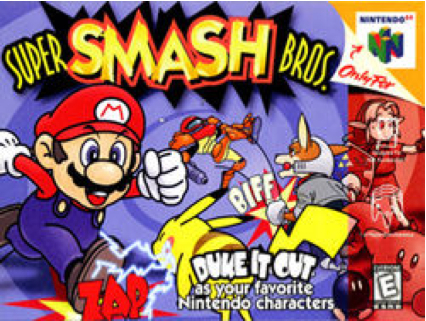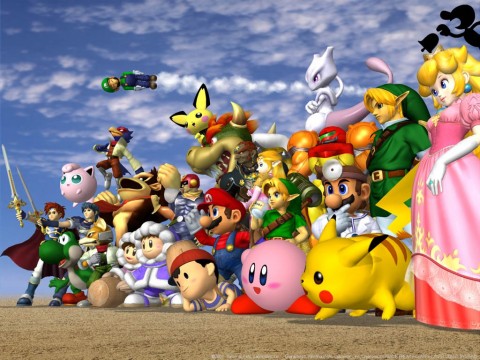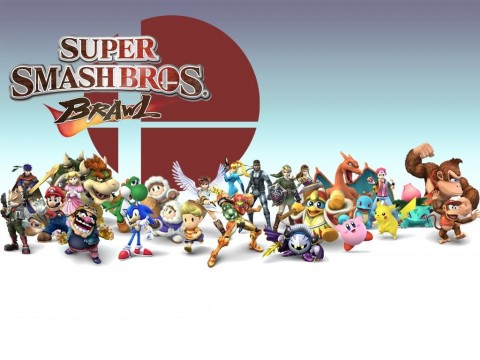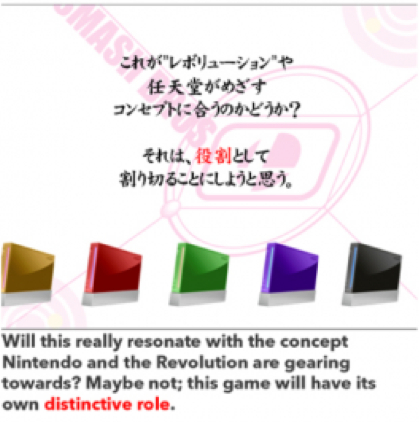
A beautiful thing was born. Super Smash Bros. sold around 2 million copies in Japan, and it was only after this domestic success that it was unleashed on the world. It sold one and a half as much in the US, and went where no fighter had gone before, both thematically (a postmodern jumble of fictional universes that takes no questions and gives no answers) and in terms of gameplay (free-floating fighters cheerfully shedding the need for a health bar). Critics roundly praised its multiplayer component as starkly original and easy to pick up.
And here’s where I may lose you, dearest reader. That the series is easy to pick up none can deny, but bickering can arise when discussing which offers the most depth for mastery. I may be crazy to table my opinion to the unforgiving wretch that is the online community, but know that I also sometimes coat myself in honey before approaching hungry bears. With the comparative danger relatively small, I must hail the one with the ten birthday candles of course: Super Smash Bros. Melee. It is in fact my favorite game of all time. When you need to find out which of your friends would have made potential Jedi if born a long time ago in a galaxy far, far away… this is your benchmark.

Wide appeal was matched by a smaller niche of elite fans. Within it item drops were routinely set to zero, and only a handful of balanced stages permitted in the circuit. Consumers quickly grasped the game’s inner workings, even when these weren’t exactly the intentions of the developers. Paramount among these was the wavedash, a technique that allows for subtle and quick movements with virtually no cooldown. A slew of other exploits were discovered, and mastery proved to be quite the rabbit hole. While Sakurai and company were aware of and condoned the wavedash– as an interview in Nintendo Power finally brings to light-– it is hard to imagine that they anticipated its wondrous implications for the pro community.
Super Smash Bros. Brawl deliberately went with a more casual route, excising the wavedash in hopes to “level the playing field” among newcomers and veterans and differentiate the game from its predecessor. On two related fronts, the Brawl success story is awe-inspiring. First was its almost improvised inception.
All the employees from Nintendo of America that were involved with E3 at the time strongly wanted to announce a new Super Smash Bros. that would be compatible with Wi-Fi play. But at the time, we still hadn’t discuss this thoroughly with HAL Laboratory yet, which shared the rights to Smash Bros. with Nintendo, and we hadn’t even begun planning out the production process. So I have announced this subject, emphasizing that I was hoping that a Smash Bros. game would be released as a Wi-Fi compatible title. However, most people from Japan that were in the conference room took this as an official announcement that Nintendo was going to release a new Smash Bros. Looking back at it now, I do regret the way I said this; you can’t blame them for interpreting it that way.
Due to a slip of the tongue of sorts, Sakurai himself learned of the project along with the gleeful public, which Iwata concedes must have been “a splash of cold water.” Yet if the announcement of Universe was a little more planned, the path to development is yet again entirely ahead of him.

Brawl’s second major achievement, especially in light of its improvised nature, is the sheer amount of content it boasts. Beyond Melee, the Wii game introduced cinematic cutscenes, the Stage Builder, third-party characters, and 30 games’ worth of music. As of last year it has sold around 9.5 million copies, which, in testament to the Wii’s success, is short of several of the console’s other commercial explosions (e.g. New Super Mario Bros. Wii, Mario Kart Wii, and Wii Fit).
So where is the series headed? Lead designer Masahiro Sakurai and Project Sora (the team behind the project) are in a similar but better position than they were when approaching the development of Brawl. Again they have no looming deadline (or years of pressure, depending on how you put it), and yet a new console to take advantage of and define. Noteworthy is that whereas character balance in the first three games was the jurisdiction of Sakurai alone, Universe will have a team working on the issue. The result, hopefully, will be a squashing of the character “tiers” quickly made (or identified, rather) by the hungry gaming community.
It would be great to see Project Sora confide pro gamers with alpha versions of Universe, for the sake of achieving depth and balance as Blizzard has done with StarCraft II. They could even promote the whole process in a public relations move certain to garner the attention of many. Unfortunately, something about Nintendo’s mores make this a doubt.
But that’s another story. Nintendo may be aloof to some things, but business sense and a fine sensitivity to the potential of game-making have always been at its core. In Iwata’s words, “making games that everyone can play doesn’t mean making simple games.” Condensed wisdom if I’ve ever seen it. Depending on how you slice the word “simple,” the series fully bolsters the idea. After all, Super Smash Bros. players make use of a rather narrow moves catalogue in a 2-D plane, and yet oh, how merrily it outdistances many best-two-out-of-three fighters in depth.
Sakurai is well aware of that, and of the niche within Nintendo that the series has come to fill. Upon the Wii’s announcement at E3 2005, he lauded the direction the company was moving in: games accessible to all and attractive to even the previously unconcerned.
At the same time, however, I didn’t think that Smash Bros. had to fully adhere to this approach. Rather, I thought that I should remain cognizant of this new concept Nintendo had developed, but then think about what development path was right for the new Smash Bros.
And thank the heavens Sakurai asserted Brawl’s prerogative to stand outside of the Wii’s philosophy. When reading his speculation on the road untaken (“we could make the art style simpler or make it possible to use Miis”) I could only hold my breath, hoping that he would damn the idea to a circle of hell deliciously uncharacteristic of Nintendo. He never quite did that, but that prerogative he labeled as the game’s “distinctive role.”

As approachable as the series may be to newcomers, Super Smash Bros. is a series destined for the octagon of sweat and strain. Therein its beauty has always lain. Here’s hoping that Project Sora survey the wishes of its fan base early and often, that the competitively-minded within it answer in droves, and that the series’ distinctive role stays strong.
Pages: 1 2




 ShareThis
ShareThis







Wow! I didn’t know Smash Bros was gonna be a different fighting game! Thanks for the info.